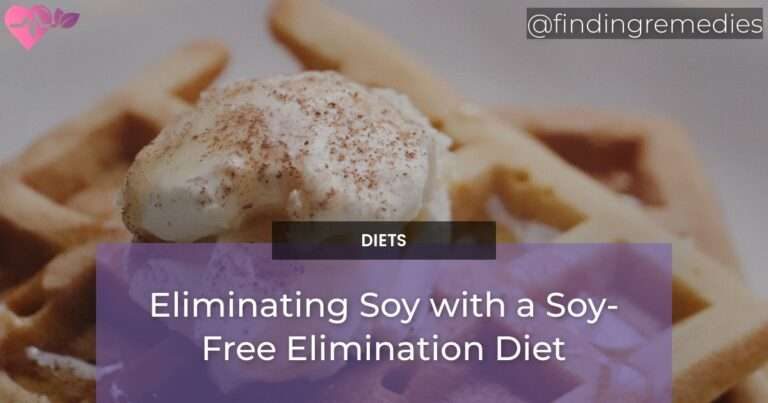Are you constantly experiencing digestive issues, skin problems, or respiratory symptoms after consuming soy products? If so, you might be suffering from a soy allergy. Soy is a common ingredient in many foods and can be found in items ranging from tofu and edamame to soy milk and soy sauce. For individuals with soy allergies, eliminating soy from their diet is essential to alleviate symptoms and improve overall health.
In this comprehensive guide, we will explore the symptoms and diagnosis of soy allergy, the importance of soy-free elimination diet, and provide you with helpful tips and delicious soy-free recipes.
So, get ready to embark on a soy-free elimination diet that will transform your health and well-being.
Table of Contents
Understanding Soy Allergy
Symptoms and Diagnosis of Soy Allergy
When someone has a soy allergy, their immune system reacts adversely to proteins found in soy. This reaction triggers various symptoms, which can manifest within minutes or hours after consuming soy-based products. Common symptoms of soy allergy include:
- Difficulty breathing or wheezing
- Skin reactions such as hives, itching, or eczema
- Digestive issues like nausea, vomiting, or diarrhea
- Swelling of the lips, tongue, throat, or face
If you suspect a soy allergy, it’s crucial to consult with a healthcare professional who can conduct a comprehensive evaluation. The diagnosis may involve a physical examination, reviewing medical history, and performing tests such as skin prick tests or blood tests to measure specific immunoglobulin E (IgE) antibodies.
Importance of Eliminating Soy from Diet
Eliminating soy from your diet is pivotal as it helps alleviate the uncomfortable and potentially life-threatening symptoms associated with soy allergy. Additionally, eliminating soy can have numerous other benefits for your health, such as:
- Improved digestion and reduced gastrointestinal distress
- Enhanced skin health and reduction in skin issues
- Decreased risk of inflammation and related conditions
- Reduced exposure to genetically modified organisms (GMOs)
By following a soy-free elimination diet, you can take control of your health and well-being while exploring exciting alternatives to soy-based products.
Exploring Soy-Free Swaps
ALSO READ
Non-Soy Protein Sources
Eliminating soy doesn’t mean compromising on protein intake. There are plenty of other excellent sources of protein that can replace soy-based products in your diet. Consider incorporating the following non-soy protein sources:
- Quinoa: A versatile grain-like seed packed with essential amino acids.
- Lentils: These legumes provide a good amount of protein and are perfect for stews and soups.
- Chickpeas: A staple in Mediterranean cuisine, chickpeas can be roasted for a crunchy snack or used to make delicious hummus.
- Seitan: Made from wheat gluten, seitan is a high-protein meat substitute often used in vegetarian and vegan dishes.
- Nuts and Seeds: Almonds, walnuts, chia seeds, and hemp seeds are all great sources of protein.
Plant-based Milk Alternatives
If you’re used to consuming soy milk, fear not! There are numerous plant-based milk alternatives available that are soy-free and equally delicious. Some popular options include:
- Almond Milk
- Oat Milk
- Coconut Milk
- Rice Milk
- Hemp Milk
These alternatives can be used in various recipes, poured over cereal, or enjoyed on their own.
ALSO READ
Soy-Free Sauces and Condiments
Sauces and condiments often contain hidden soy ingredients. However, there are plenty of soy-free options available that can add flavor to your dishes. Look for products that are labeled as soy-free or consider making your own homemade versions of condiments like:
- Tomato Ketchup
- Mustard
- Barbecue Sauce
- Salad Dressings
- Hot Sauce
By being mindful of the ingredients and opting for soy-free alternatives, you can continue to enjoy deliciously flavored meals without the worry of triggering soy allergy symptoms.
Can a Soy-Free Elimination Diet Help with Corn Allergies?
A cornfree elimination diet can be a helpful approach for individuals with corn allergies. By removing soy products from their diet, individuals can further reduce the risk of triggering allergic reactions. This diet aims to identify and eliminate triggers, allowing those with corn allergies to better manage their condition and enhance their overall well-being.
Conclusion
Living a soy-free lifestyle is definitely doable and can be one of the most beneficial changes you make for the health of your whole family. Eliminating soy from your diet will not only help to reduce inflammation and improve gut health, but it can also help to improve your mood and energy levels, and even reduce your risk of certain chronic diseases. Even if you are not dealing with a soy allergy or soy sensitivity, it can still be beneficial to limit your consumption of soy-based products. You can get creative with meal planning in order to avoid soy while still eating a balanced, nutrient-dense diet. By eliminating soy from your family’s diet and replacing it with non-soy alternatives, you can improve your overall health.

